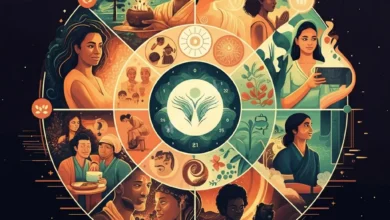The Kindness Echo: How Empathy Builds Community Wellness

Have you ever noticed how a simple act of kindness can brighten your entire day? Imagine if that feeling could spread throughout an entire community. Welcome to the concept of the “Kindness Echo” – a powerful idea that shows how empathy and kindness can create waves of positive change in our communities.
Recent research from the University of California, Berkeley, found that witnessing acts of kindness can actually improve heart health and lower blood pressure. This fascinating discovery highlights the deep connection between empathy, kindness, and community wellness. In this article, we’ll explore:
- How the Kindness Echo works
- Why empathy is so important
- How you can help build a happier, healthier community through simple acts of compassion
Understanding Empathy and Its Importance

Empathy is the ability to understand and share the feelings of another person. It’s like putting yourself in someone else’s shoes. There are two main types of empathy:
- Cognitive empathy: Understanding another person’s thoughts and feelings
- Emotional empathy: Actually feeling what another person is experiencing
Why is empathy so crucial for human connections? It’s the glue that holds our communities together. When we empathize with others, we create stronger bonds and build trust.
The benefits of empathy for individual and community well-being are numerous:
- Improved mental health: Empathy reduces feelings of loneliness and isolation
- Better relationships: It helps us communicate more effectively and resolve conflicts
- Increased cooperation: Empathetic communities work together more efficiently
- Reduced stress: Understanding others can lower our own stress levels
- Greater innovation: Diverse perspectives fostered by empathy lead to creative solutions
- Enhanced social support: Empathetic communities provide stronger support networks
By cultivating empathy, we’re not just helping others – we’re also improving our own lives and the overall health of our communities.
The Ripple Effect of Kindness

Imagine tossing a pebble into a calm pond. The small splash creates ripples that spread far beyond the initial point of impact. This is exactly how the “Kindness Echo” works in our communities.
When we perform an act of kindness, it doesn’t just affect the recipient. It creates a positive chain reaction that can influence countless others. Here’s how it works:
- You perform a kind act
- The recipient feels good and is inspired to be kind to someone else
- That person, in turn, passes on the kindness
- The cycle continues, creating a ripple effect of positivity
Examples of how small acts can lead to larger community impacts:
- Helping a neighbor: This could inspire them to volunteer at a local food bank
- Complimenting a coworker: They might feel motivated to mentor a new employee
- Picking up litter: Others might see and join in, leading to a community clean-up event
This concept is often called “paying it forward”. It’s the idea that instead of paying back kindness directly, we pass it on to others, creating an ongoing cycle of goodwill.
Initial act of kindness → 2. Recipient feels appreciated → 3. Recipient inspired to be kind → 4. New act of kindness → 5. Cycle repeats
By understanding this ripple effect, we can see how even our smallest actions can contribute to building a kinder, more empathetic community.
Building Empathy in Communities
Creating a more empathetic community doesn’t happen overnight, but there are several key areas we can focus on to nurture this important quality:
Fostering Open Communication
Active listening is at the heart of empathetic communication. It involves fully concentrating on what someone is saying, rather than just passively hearing their words. Here are some tips to improve your active listening skills:
- Give your full attention to the speaker
- Avoid interrupting or jumping to conclusions
- Use non-verbal cues to show you’re engaged (nodding, maintaining eye contact)
- Ask clarifying questions to ensure understanding
- Reflect back what you’ve heard to confirm your interpretation
Creating safe spaces for sharing experiences is also crucial. These are environments where people feel comfortable expressing themselves without fear of judgment or ridicule. This could be a community center, a support group, or even a regular neighborhood gathering.
Promoting Diversity and Inclusion
Diverse perspectives are the backbone of empathy. When we interact with people from different backgrounds, we broaden our understanding of the world and develop greater empathy. Here are some ways to celebrate differences within a community:
- Organize cultural festivals or food fairs
- Host community discussions on diverse topics
- Support local businesses owned by people from various backgrounds
- Encourage multilingual signage in public spaces
Successful inclusive community initiatives might include:
- Buddy programs pairing newcomers with long-time residents
- Intergenerational projects bringing together young and old
- Accessible public spaces designed for people of all abilities
Encouraging Volunteer Work and Community Service
Volunteering is a powerful way to build empathy. It exposes us to different life experiences and helps us understand the challenges others face. Here’s a quick look at various types of community service and their impacts:
| Type of Service | Community Impact | Personal Benefit |
|---|---|---|
| Food banks | Reduces hunger | Gratitude for own resources |
| Mentoring programs | Supports youth development | Develops leadership skills |
| Environmental clean-ups | Improves local environment | Increases environmental awareness |
| Elder care | Supports aging population | Gains wisdom from older generations |
By engaging in these activities, we not only help others but also grow our own capacity for empathy and understanding.
The Impact of Empathy on Community Wellness
Empathy doesn’t just make us feel good—it has tangible benefits for both individual and community health. Let’s explore these impacts in more detail:
Mental Health Benefits
Reducing isolation and loneliness: When people feel understood and supported, they’re less likely to experience the negative effects of social isolation. Empathetic communities create a sense of belonging that can combat loneliness, a growing health concern in many societies.
Stress reduction: Empathy helps create a supportive environment where people feel comfortable sharing their burdens. This shared support system can significantly reduce stress levels within a community.
Preventing and addressing mental health issues: In empathetic communities, people are more likely to:
- Notice when others are struggling
- Offer support without judgment
- Encourage seeking professional help when needed
This proactive approach can help prevent mental health issues from escalating and ensure that those who need help receive it sooner.
Physical Health Improvements
A supportive, empathetic community can have surprising effects on physical health:
- Encouraging healthy behaviors: When we care about our community, we’re more likely to engage in activities that benefit everyone’s health, like community clean-ups or group exercise programs.
- Social connections and physical health: Strong social ties, built on empathy, have been linked to lower blood pressure, reduced risk of cardiovascular disease, and even longer life expectancy.
- Community wellness initiatives: Empathetic communities often create programs that directly impact physical health, such as:
- Community gardens promoting healthy eating
- Neighborhood watch groups improving safety and reducing stress
- Support groups for managing chronic illnesses
Stronger Social Bonds
Empathy is the foundation for building robust community relationships:
Fostering trust and cooperation: When people feel understood and valued, they’re more likely to trust and cooperate with others. This can lead to more effective problem-solving and community-wide improvements.
Building social capital: This refers to the networks of relationships that help a society function effectively. Empathetic communities tend to have higher social capital, which can lead to:
- Better economic opportunities
- Improved public services
- Higher levels of civic engagement
Overcoming challenges together: Empathetic communities are more resilient in the face of adversity. Whether it’s a natural disaster or an economic downturn, these communities pull together, support each other, and find innovative solutions.
By nurturing empathy, we’re not just improving individual lives—we’re creating healthier, happier, and more resilient communities overall.
Practical Steps to Cultivate Empathy in Your Community

Building a more empathetic community starts with individual actions. Here are some practical steps you can take:
Daily Empathy Practices for Individuals
- Practice active listening: Give your full attention when others are speaking.
- Seek diverse perspectives: Engage with people from different backgrounds.
- Volunteer regularly: Even a few hours a month can make a difference.
- Show random acts of kindness: Hold a door, offer a compliment, or help carry groceries.
- Challenge your own biases: Reflect on your prejudices and work to overcome them.
Community-Wide Initiatives
- Empathy workshops: Organize sessions teaching empathy skills to various age groups.
- Community storytelling events: Create platforms for sharing personal experiences.
- “Walk in My Shoes” programs: Arrange experiences that help people understand different life situations.
- Intergenerational mentoring: Pair older adults with youth for mutual learning.
- Inclusive community spaces: Design public areas that encourage interaction among diverse groups.
The Role of Education and Awareness
Education plays a crucial role in building empathetic communities:
- School programs: Implement empathy-focused curricula in local schools.
- Adult education: Offer courses on emotional intelligence and communication skills.
- Public awareness campaigns: Use local media to highlight the importance of empathy.
- Book clubs or film screenings: Choose materials that promote understanding of different experiences.
Remember, cultivating empathy is an ongoing process. Small, consistent efforts can lead to significant changes over time.
Overcoming Challenges in Building Empathetic Communities
While the benefits of empathy are clear, creating an empathetic community isn’t always easy. Let’s address some common obstacles and strategies to overcome them:
Common Obstacles to Empathy
- Prejudice and stereotypes: Preconceived notions can hinder our ability to empathize with others.
- Busy lifestyles: In our fast-paced world, we often don’t take the time to truly connect with others.
- Digital communication: While technology connects us, it can also create emotional distance.
- Fear of vulnerability: Opening up to others can feel risky or uncomfortable.
- Lack of exposure to diversity: Limited interaction with different groups can make empathy challenging.
Strategies for Overcoming Challenges
- Educate and raise awareness: Regular workshops and discussions can help break down prejudices and stereotypes.
- Prioritize face-to-face interactions: Encourage community events that bring people together in person.
- Practice mindfulness: This can help us slow down and be more present with others.
- Create safe spaces: Establish environments where people feel comfortable being vulnerable.
- Promote diversity in leadership: Ensure various perspectives are represented in community decision-making.
The Importance of Persistence and Patience
Building empathy takes time. It’s important to:
- Celebrate small wins: Acknowledge even minor improvements in community empathy.
- Learn from setbacks: Use challenges as opportunities for growth and learning.
- Maintain consistency: Regular, ongoing efforts are more effective than one-time initiatives.
- Lead by example: Be the change you want to see in your community.
Remember, every act of empathy, no matter how small, contributes to a more compassionate community. With persistence and patience, we can overcome these challenges and create lasting change.
Conclusion
As we’ve explored throughout this article, the “Kindness Echo” is a powerful force for positive change in our communities. Let’s recap the main points we’ve covered:
- Empathy is the foundation for strong, healthy communities.
- Small acts of kindness can create a ripple effect, impacting far more people than we might imagine.
- Building empathy involves fostering open communication, promoting diversity, and encouraging community service.
- Empathetic communities enjoy significant benefits, including improved mental and physical health, and stronger social bonds.
- While there are challenges to building empathy, with persistence and the right strategies, we can overcome them.
The long-term benefits of building empathetic communities are profound. By cultivating empathy, we’re not just improving our immediate surroundings—we’re contributing to a more compassionate, understanding world.
Remember, every one of us has the power to start our own “Kindness Echo.” It begins with a single act of empathy or kindness. Whether it’s lending a listening ear to a neighbor, volunteering at a local charity, or simply being more patient in our daily interactions, these small actions can spark significant change.
So, why not start today? Your act of kindness could be the beginning of a beautiful transformation in your community. After all, in the words of Mother Teresa, “We can do no great things, only small things with great love.”
Let’s create a world where empathy echoes through every community, building a brighter, more connected future for all.



